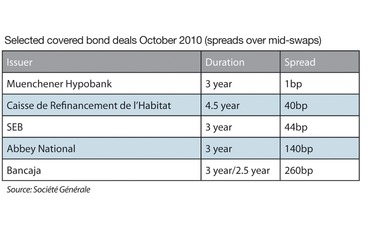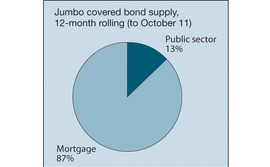
This article was paid for by a contributing third party.More Information.

Stabilisation funds could become big beasts in bonds

The landscape of the EMU bond market is changing. New AAA-rated issuers will soon compete with established sovereigns and agencies for a share of the safe and liquid savings market. Here at Commerzbank we believe that a modest swap spread tightening could result, but neither the unique status of Bunds, nor the structural low yield environment is in jeopardy. A closer look at balance sheet mechanics shows that the euro front end should continue to underperform, adding to curve flattening.
Two new sovereign/agency issuers are being set up: the European Financial Stability Facility (EFSF) and the Finanzmarkt Stabilisierung Wertmanagement (FMSW). These issuers should provide the markets with sizable AAA-rated zero-risk weighted supply by next year.
EFSF – a vehicle on the road to common EU issuance
The EFSF was established on May 9 as an integral part of the €750bn bailout package set up by the EMU member states in liaison with the European Commission, the ECB and the IMF. It is a Luxembourg-registered company constructed as a special-purpose vehicle (SPV), which will use the operational platform of the German Finanzagentur for potential issuance. It is owned by euro area member states and will have the capacity to issue bonds guaranteed by these members for up to €440bn for on-lending to euro area member states in difficulty.
The EFSF has been formally up and running since early August, when official national approval by all euro area member states was completed. The three major rating agencies have granted the EFSF AAA/Aaa status.
Of course it is difficult to predict with certainty what effect EFSF issuance will have, given that it is not even clear whether this fund will ever become active in the primary market. A potential funding requirement arises if EMU members call for, and the EU grants, financial assistance. As we see it, the EFSF could issue between €250bn and €300bn in AAA-rated paper to support ailing EMU peers. Initial issuance to support smaller countries would of course be much smaller. But, if a funding need arises, a double-digit billion euro funding programme should be considered to secure secondary market liquidity.
What are the odds of this happening? At Commerzbank we have argued before that it is highly unlikely that the EFSF will spring into action this year. This is because Greece has a separate rescue umbrella, Ireland is fully funded and only a residual funding risk remains for Portugal. In the coming years, however, we see a high probability that the EFSF will be activated when tensions re-emerge. Economic growth in many EMU countries will most likely fall short of the expectations embedded in the stability programmes. The risk is real that ‘austerity fatigue’ will set in and spreads will come under renewed upward pressure after the current relaxation phase.
 By next year it could therefore become tempting to call on the EFSF, and the desire by many EU politicians to move toward some form of common issuance should accentuate these calls. The Greek bailout package could well be extended. With GGB redemptions increasing from 2013, Greece would have to raise more than €200bn in the market until the end of 2015 if it were asked to redeem the EU and IMF loans together with its regular redemptions. This makes an extension of aid likely to avoid default. The EFSF, or European Monetary Fund (EMF) as it may then be called, will most likely play an integral part in this.
By next year it could therefore become tempting to call on the EFSF, and the desire by many EU politicians to move toward some form of common issuance should accentuate these calls. The Greek bailout package could well be extended. With GGB redemptions increasing from 2013, Greece would have to raise more than €200bn in the market until the end of 2015 if it were asked to redeem the EU and IMF loans together with its regular redemptions. This makes an extension of aid likely to avoid default. The EFSF, or European Monetary Fund (EMF) as it may then be called, will most likely play an integral part in this.
FMSW – large funding need but limited issuance
The FMSW is a specialist institution in the form of a public sector agency within the Federal Agency for Financial Market Stabilisation (FMSA). It was created at the start of October when comprehensive risk positions and non-strategic segments from Hypo Real Estate Group (HRE) were spun off into this new institution.
Assessing FMSW funding is not much easier than EFSF funding at this stage, but at least some more tangible ballpark figures on the assets and liabilities are available. The numbers are not insignificant: €173bn in assets were transferred from HRE to FMSW, which will wind them down over the next 10 years. The liabilities picture is less clear. The only official statement from FMSW is that some €124bn in SoFFin guaranteed issuance will be replaced through FMSW issuance by the middle of next year.
The FMSW will certainly become a major borrower in the Eurozone market, although it seems fair to assume that only a small part of the refinancing will initially be conducted via capital market issuance. Instead, a more diversified funding strategy is likely to be seen with FMSW bond issuance, perhaps in the lower double-digit billion euros range.
 Crucially, however, the remainder of the assets will also have to be funded, and this is where it could become interesting for money markets. Despite the colloquial label ‘bad bank’, the FMSW does not have a banking licence and so does not qualify as a counterparty in ECB operations. Indirect ECB access via other counterparties (first and foremost HRE) could initially be used. However, given its German sovereign credit quality, it should be possible for FMSW to secure cheaper repo market funding before long, reducing the claim on ECB funding over time.
Crucially, however, the remainder of the assets will also have to be funded, and this is where it could become interesting for money markets. Despite the colloquial label ‘bad bank’, the FMSW does not have a banking licence and so does not qualify as a counterparty in ECB operations. Indirect ECB access via other counterparties (first and foremost HRE) could initially be used. However, given its German sovereign credit quality, it should be possible for FMSW to secure cheaper repo market funding before long, reducing the claim on ECB funding over time.
Market implications
The advent of new AAA-rated entities with a funding need higher than €100bn from now until next summer should not go unnoticed in the Eurozone bond market. Weighing all the unknowns, we at Commerzbank see implications that include modest Bund swap spread tightening and euro curve flattening.
The supply impact to Bunds should be negligible. Until the EFSF becomes an established issuer with the potential to dilute German credit, a bumpy political process is likely to cause a renewed flight to quality and liquidity. So EMU spreads are more likely to re-widen next year before potentially tightening further down the road. FMSW funding will add to German supply. However, the agency can be expected to pursue a diversified funding strategy, keeping capital market issuance limited in order not to trigger undue price concessions.
For next year we are expecting close to €500bn of bond issuance from AAA-rated EMU sovereigns. Against this, a low double-digit euro billion figure from FMSW should hardly cause indigestion. More competition could be seen with other German agencies as the FMSW may become the second largest agency issuer after KfW, competing for a similar investor base.
While the supply impact on Bunds should thus remain muted, an adverse effect on other agencies and weaker AAA sovereign credits cannot be ruled out. A modest swap spread tightening impact in intermediate to longer maturities should still be seen given that issuance from the new entities is likely to be swapped. Bund swap spreads should thus remain tighter next year than would otherwise be the case when tensions re-emerge.
At the euro front end, a reduced reliance on ECB funding via the FMSW should add to the upside pressure on overnight and repo rates by early next year. In Commerzbank’s independent weekly research publication Ahead of the Curve, we have already suggested that the ECB has a vested interest in shedding its role as central counterparty and bond buyer of last resort. Recent events have strengthened our faith in this respect. The FMS model is probably what ECB president Jean-Claude Trichet had in mind when saying that the ECB will ask “the appropriate decision-makers to do what is necessary”. The greater discretionary powers the ECB has granted itself in October to ban counterparties or collateral from its operations can also be interpreted as another gesture to accentuate this appeal.
The excess liquidity in the euro money market shrank considerably at the start of October. The upshot is that EONIA and related rates are likely to come under more upside pressure, potentially rising by more than forwards predict in Q1 2011, causing more of a euro flattening bias for the euro swaps and Bund curve.
Sponsored content
Copyright Infopro Digital Limited. All rights reserved.
You may share this content using our article tools. Printing this content is for the sole use of the Authorised User (named subscriber), as outlined in our terms and conditions - https://www.infopro-insight.com/terms-conditions/insight-subscriptions/
If you would like to purchase additional rights please email info@risk.net
Copyright Infopro Digital Limited. All rights reserved.
You may share this content using our article tools. Copying this content is for the sole use of the Authorised User (named subscriber), as outlined in our terms and conditions - https://www.infopro-insight.com/terms-conditions/insight-subscriptions/
If you would like to purchase additional rights please email info@risk.net